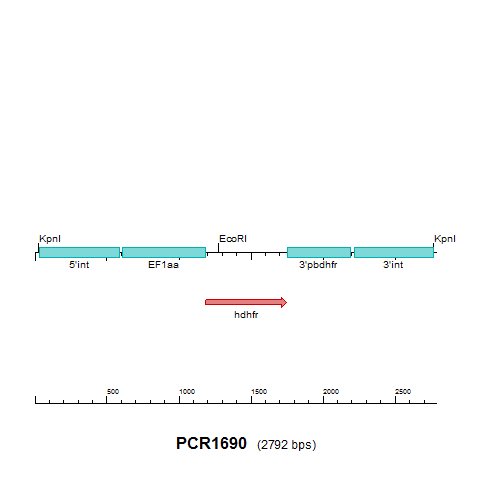SummaryRMgm-807
|
||||||||||
Last modified: 23 December 2016, 17:40
 *RMgm-807
*RMgm-807| Successful modification | The gene/parasite could not be changed/generated by the genetic modification. |
| The following genetic modifications were attempted | Gene disruption |
| Number of attempts to introduce the genetic modification | ≥ 5 |
| Reference (PubMed-PMID number) |
Reference 1 (PMID number) : 25941254 |
| top of page | |
| Parent parasite used to introduce the genetic modification | |
| Rodent Malaria Parasite | P. berghei |
| Parent strain/line | P. berghei ANKA |
| Name parent line/clone | P. berghei ANKA 676m1cl1 (RMgm-29) |
| Other information parent line | 676m1cl1 (RMgm-29) is a reference ANKA mutant line which expresses GFP-luciferase under control of a constitutive promoter. This reference line does not contain a drug-selectable marker (PubMed: PMID: 16242190). |
| top of page | |
| Attempts to generate the mutant parasite were performed by | |
| Name PI/Researcher | J. Lin; C.J. Janse; S.M. Khan |
| Name Group/Department | Leiden Malaria Research Group |
| Name Institute | Leiden University Medical Center |
| City | Leiden |
| Country | The Netherlands |
 Disrupted: Mutant parasite with a disrupted gene
Disrupted: Mutant parasite with a disrupted gene| top of page | |||||||||||||||||||||||||
| Details of the target gene | |||||||||||||||||||||||||
| Gene Model of Rodent Parasite | PBANKA_1310600 | ||||||||||||||||||||||||
| Gene Model P. falciparum ortholog | PF3D7_1446800 | ||||||||||||||||||||||||
| Gene product | heme detoxification protein | ||||||||||||||||||||||||
| Gene product: Alternative name | HDP | ||||||||||||||||||||||||
| top of page | |||||||||||||||||||||||||
| Details of the genetic modification | |||||||||||||||||||||||||
| Inducable system used | No | ||||||||||||||||||||||||
| Additional remarks inducable system | |||||||||||||||||||||||||
| Type of plasmid/construct used | (Linear) PCR construct double cross-over | ||||||||||||||||||||||||
| PlasmoGEM (Sanger) construct/vector used | No | ||||||||||||||||||||||||
| Modified PlasmoGEM construct/vector used | No | ||||||||||||||||||||||||
| Plasmid/construct map |
 | ||||||||||||||||||||||||
| Plasmid/construct sequence |
  GAACTCGTACTCCTTGGTGACGGGTACCTTTGTGGAACTTAAAATTTGCATAAAAAATAT
| ||||||||||||||||||||||||
| Restriction sites to linearize plasmid | |||||||||||||||||||||||||
| Partial or complete disruption of the gene | Complete | ||||||||||||||||||||||||
| Additional remarks partial/complete disruption | |||||||||||||||||||||||||
| Selectable marker used to select the mutant parasite | hdhfr | ||||||||||||||||||||||||
| Promoter of the selectable marker | eef1a | ||||||||||||||||||||||||
| Selection (positive) procedure | pyrimethamine | ||||||||||||||||||||||||
| Selection (negative) procedure | No | ||||||||||||||||||||||||
| Additional remarks genetic modification | The unsuccessful attempts to delete this gene indicates an essential role for blood stage growth/multiplication. Attempts to disrupt the P. falciparum hdp gene were also unsuccessful. Malaria parasites digest hemoglobin within a food vacuole to supply amino acids, releasing the toxic product heme. During the detoxification, toxic free heme is converted into an insoluble crystalline form called hemozoin (Hz). Heme detoxification protein (HDP) in Plasmodium falciparum is one of the most potent of the hemozoin-producing enzymes. In the first unsuccessful attempt to disrupt the gene described here (experiment 1748), the locus was targeted using a linear construct that was generated using a 2-step, anchor tagging PCR method (for primer details see below). The 5’- and 3’ targeting regions of the gene were PCR amplified from genomic DNA using primer pairs 1&2 and 3&4. Primers 2 and 3 have 5’-terminal extensions homologues to the hDHFR selectable marker cassette. Primers 1 and 4 both have a 5’-terminal overhang with an anchor-tag which serves as a primer site in the 2nd PCR reaction. The target fragments from the first PCR reaction were annealed to either side of the selectable marker cassette by PCR with anchor-tag primers 5 and 6, resulting in the 2nd PCR product. The hDHFR selectable marker cassette used in this reaction was digested from pL0040 using restriction enzymes XhoI and NotI. pL0040 is available from The Leiden Malaria Research Group. See for more information on the 2-step anchor tagging PCR method, the following publications: J.W. Lin, S.M. Khan et al. A novel 'gene insertion/marker out' (GIMO) method for transgene expression and gene complementation in rodent malaria parasites PLoS One. 2011;6(12). T. Annoura et al. Assessing the adequacy of attenuation of genetically modified malaria parasite vaccine candidates Vaccine. 2012;30(16):2662-70 The experiment was repeated 4 more times without success: twice using the same PCR targeting construct (experiments 1778 and 2212) and two more times with a PCR targeting construct having the same targeting regions but with the positive-negative selectable marker (PCR1762, experiments 2208 and 2213). Experiment 2208 was done in the cl15cy1 background. An independent unsuccessful attempt in the cl15cy1 background was done by the group of Roberta Spaccapelo (University of Perugia, Italy) using a circular, double cross-over targeting plasmid (pPhHDP). The 5' targeting region was amplified using primer pair R724/R725 (CCGGGCCCGCGGCAGCCACTATACTATTTTTATGCTG / GGGGATCGATCGGAAGCATTCACATAAATATTGC). The 3' targeting region was amplified using primer pair R726/R727 (GGGGGAATTCCTATTTAAATGAAGATTTTCCATATATTCAG / AAGGAAAAAAGCGGCCGCGGTTGAATCCTAATTCAGTATTGATTG) | ||||||||||||||||||||||||
| Additional remarks selection procedure | |||||||||||||||||||||||||
|
Primer information: Primers used for amplification of the target sequences
 Primer information: Primers used for amplification of the target sequences

| |||||||||||||||||||||||||
| top of page | |||||||||||||||||||||||||

